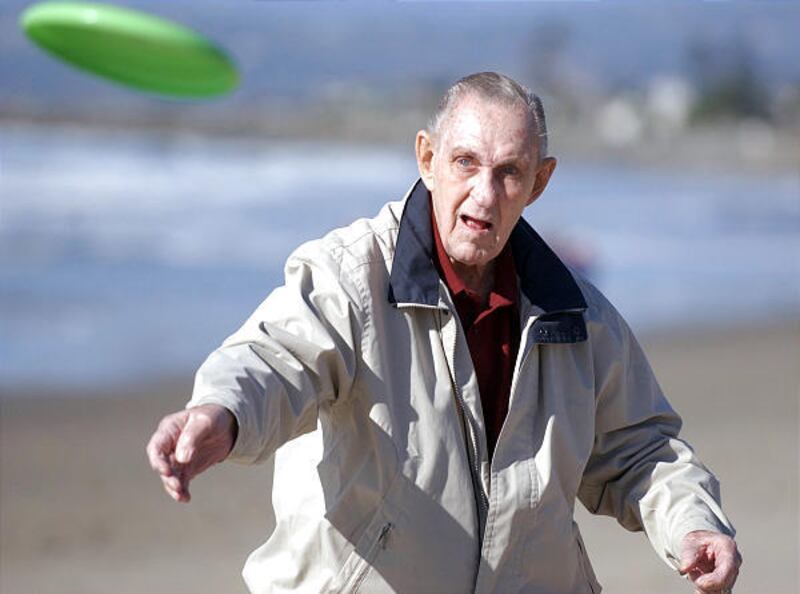Pie plates. A popcorn tin. Aerodynamics. Plastics. Fun. Somehow, they all came together to create one of America's favorite toys: the Frisbee.
You could say the story began in 1871, when a man named William Russell Frisbie started a pie bakery in Bridgeport, Conn. Or, in 1915, when his descendant, Joe, built a larger factory — big enough that his workers had some free time and reportedly began throwing empty pie plates around.
Or, a few years later when that catch-and-toss practice had spread not only to nearby Yale, but to other college campuses in the Northeast. As Tim Walsh notes in his book "Timeless Toys," "college kids embraced the new pastime.
"Along with the Frisbie pie tins, other forms of flying disks emerged from everyday household items. Metal cookie-can covers soared but were more than a little scary to catch. Cardboard ice cream-container lids and woven paper-plate holders weren't as dangerous, but both were so light they couldn't sail very far."
That was the state of things when a man named Walter Frederick Morrison, born in Richfield, Utah, but then living in California, enters the story.
During a Thanksgiving Day family picnic in 1937, Morrison and his girlfriend, Lu Nay (later his wife), began throwing the lid of a large popcorn tin back and forth and apparently Morrison discovered a passion that would fuel his future.
They found that the popcorn tin soon dented, which led to their discovery that cake pans flew better. Soon they began selling them on the Santa Monica, Calif., beaches for 25 cents each.
During World War II, Morrison learned something about aerodynamics as a bomber pilot. And during his incarceration as a POW in the infamous Stalag 13, his thoughts returned often to his beach outings and to perfecting a design for a better flying device.
After the war, Morrison teamed up with another former pilot named Warren Franscioni, and they hit on the idea of using the new post-war plastics as a lightweight but strong substitute for metal. Their first design was dubbed the Whirlo-Way.
As the nation became taken with the idea of invading space aliens and UFOs, the men changed their product to a "Flyin' Saucer."
They sold some to stores, but as Walsh notes, "the Flyin' Saucer had to be seen to be believed," so they began demonstrating it wherever they could find a crowd, taking it to fairs and other gatherings across the country. Still, it was slow to take off.
Franscioni left the partnership in late 1950 to return to the Air Force, but Morrison, then working as a building inspector in Los Angeles, continued to tinker with his flying disc. In 1955, he improved the design by adding a deeper and thicker rim and began to call it the "Pluto Platter."
Morrison was selling his platters mostly by mail order, when they came to the attention of Wham-O, a hunting-goods company that was looking to expand into the sporting-goods field. Wham-O loved his idea.
Meanwhile, college kids in the East were still throwing their pie tins, and other companies had begun to produce plastic discs under various flying saucer and "sky-pie" names. Whatever the brands, however, they all seemed to be known as Frisbies, in honor of the old pie company. Wham-O executives decided to cash in on that popularity, changing the spelling slightly to Frisbee, so they could apply for a trademark under that name.
Morrison's design proved to be a winner — a disc that could fly farther and with better accuracy than a pie plate and could be caught easily and without inflicting as much damage. A new American pastime was born — one that could be enjoyed in casual backyard play as well as in highly competitive sports.
According to the Wham-O company history, "the Frisbee has not undergone many changes since its inception 50 years ago, with the exception of when Ed Headrick added the patented flight ridges to the top of the disc in 1964. This feature radically improved the disc's stability and speed, ushering in a new era of performance-based Frisbee and the creation of dozens of new Frisbee-based competitive individual and team sports."
Today, more than 45 million people worldwide engage in Ultimate Frisbee, Freestyle Frisbee and Frisbee Golf, says the company. "Not since the invention of the ball have so many fun games and competitive sports been derived from such a simple object."
In an official 50th anniversary statement, 87-year-old Morrison, who now lives in Monroe, Utah, summed up his feelings about his invention: "The world has changed a lot in the past 50 years, but the original purpose of Frisbee has remained constant. Just seeing the smile on a child's face as he or she catches a soaring disc on a summer afternoon in the park, or a grown-up diving headfirst to grab a falling disc, that is what the spirit of the Frisbee is all about. Who could ever imagine this? From such a simple beginning 50 years ago, to have it become what it has become. My goodness, it's amazing."
E-mail: carma@desnews.com


